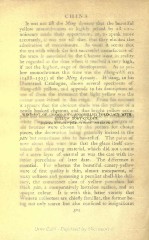Page 376 - Oriental Series Japan and China, Brinkly
P. 376
CHINA
It was not till the Ming d it the beautiful
yellow nr ' by all con-
noisseurs to speak more
accurate] \ y elicited the
it seems that
admir.1 c-urs.
the er i tirst suv . inufacture of
the ware :he Chinese must in reality
be regarded a& the time when it ; a very high,
if not the highest, stage velopn As to yel-
low monochromes this ti iung-chih era
188-1505) of the Ming dynasty. H'siang, in his
ited Catalogue, shows several specimens of
L-How, and appends to his description of
t yellow was the
-
it appears that the chot
newly husked chestnut, and that bright yellow occu-
WITH
WINE-POl OF CHYEENLGL-OHWWMA),^W^c^B\ltlth^PQy$LhV*
(Catalogue of' H'siaSP^Pfiiht^nehes. (See page 192.)
were chosen or choice
pieces, the decorati iy incised in the
pdte but sonv
s-relief. The point of
note about this WAIT was that the glaze itself con-
&H ring material, which did not consist
> < ' enamel as was the case with in-
lor porcelains of later date. The difference is
ssential. For whereas the beautiful canary-yellow
ware of first quality is thin, almost transparent, of
.xy softness ;i'ul possessing a peculiar shell-like d
y, the commoner class of yellow por* has
<ek pate, a comparatively lustreless surface, and an
ique colour. It is with this, latter variety that
Western collectors are chiefly familiar, the former be-
; not only scarce but also confined to insignificant
34

